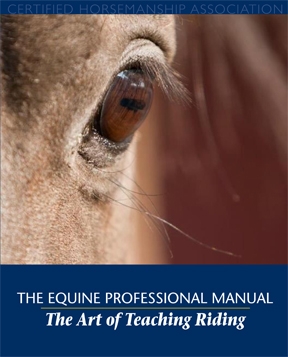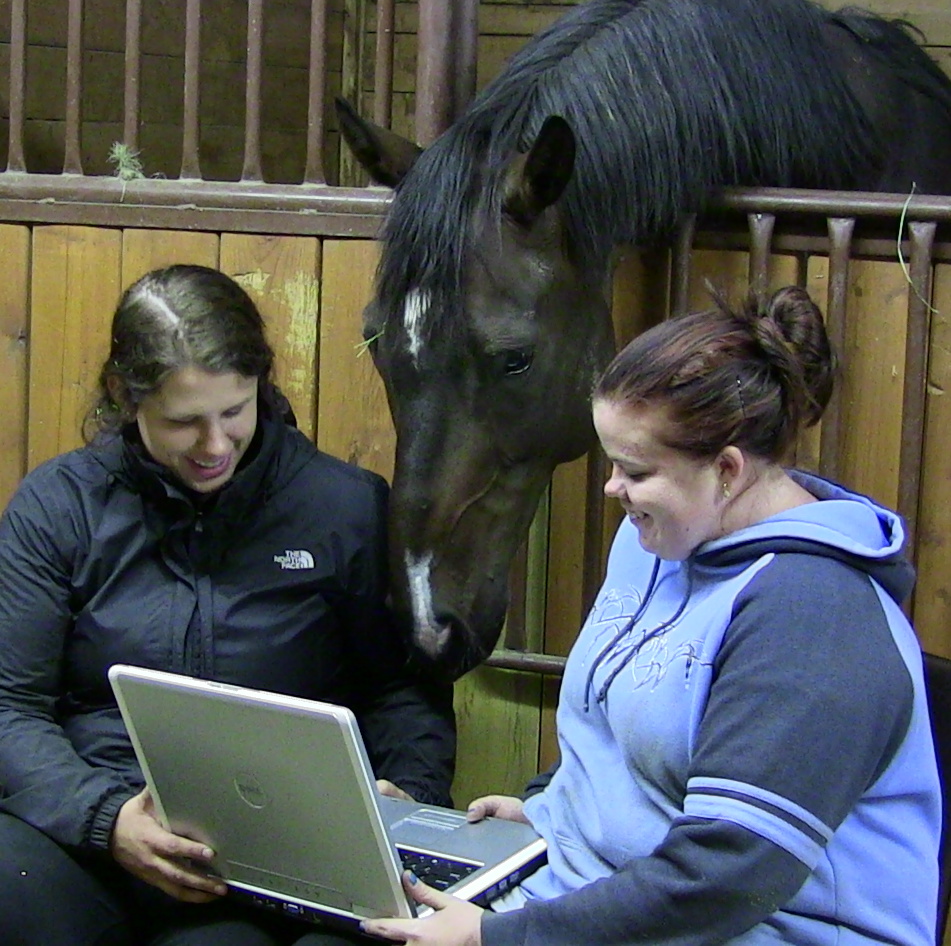The Art of Teaching Riding
CHA’s latest manual, The Equine Professional Manual—The Art of Teaching Riding, was written by a committee of experienced riding instructors and educators. The following is an abridged except from various sections in the manual.
Classifying or Grouping Riders
Grouping riding students according to experience level and ability is the preferable way to organize groups. There will be some variation within each riding group.
- It is more difficult to teach a group that has both beginners and advanced riders.
- When dealing with groups of mixed ability, use the assistant instructors to give more individual attention.
- Advanced riders may also be challenged by the horses that the advanced riders are assigned to ride.
Riding instructors need to take into consideration age, attitude, and the physical abilities of the riders when grouping riders.
- Older teenagers or adults may be embarrassed if they are placed in a class of younger children.
- Physical abilities would include how athletic the rider is and any special needs. Riders who are overweight, awkward, uncoordinated, or have other special needs require particular consideration.
Instructors need to keep in mind the purpose of the lesson as well as the riding abilities when grouping riders.
- If the purpose is for families to enjoy a lesson together, then a mixture of ages, experience, and attitudes should be expected and accommodated.
- Questioning the student may approximate riding ability, but a more accurate determination of the student’s riding ability would include a brief evaluation ride.
- When giving evaluation rides, it is more desirable to under-mount the new riders than to over-mount them. Use very quiet, reliable horses and evaluate the rider’s position, stopping, and simple control of the horse.
- Preset standards will help determine which group a student belongs in.
- A novice class of riders may have never ridden before; a beginner class may be able to walk and trot; and an intermediate class may be capable of walk, trot, and canter.
- The CHA Levels 1, 2, 3, and 4 may be used to divide riders into riding groups.
- The instructor might consider creating an evaluation checklist of skills and mark off each skill as the student rides in an evaluation ride.
Methods of Presentation
To communicate information, the method chosen may depend on the material being presented, students being taught, and environment and resources that are available. It is best to use more than one method; some people understand and respond to one method better than another.
Explanation: An explanation tells the rider how to do something, such as how to hold the reins or how to find the takeoff point for a jump.
- Explanations must be clear, short, to the point, and with key phrases to remember.
- Make explanations positive.
- Tell how to do something, instead of how not to do something.
Demonstration: Demonstrations show how to do something, such as mounting or use of a curry comb, and should be brief and to the point.
Practice or Repetition: Physical skills require practice in order to develop strength, flexibility, and motor patterns. Students need repetition and practice to learn a new skill or to improve on a learned skill.
Correction: Correction leads to mastery of a skill. Anyone learning a new skill is bound to make some errors, and the individuals must rectify those errors to correctly and safely master the skill.
- Be positive and supportive in correction. Show the students why it is easier and better to use the correct technique and how an incorrect technique will handicap the student. (For instance, have riders try balancing in two-point position with their heels down and then try balancing up on their toes; riders can feel the insecurity balancing on their toes).
- Be very specific in telling students exactly how to correct their errors. It is not enough to say, “Get those legs in.” The students must be shown how.
Discussion: Discussion combines input from the instructor with input from the students. In order to have a discussion on a topic, everyone must have at least some knowledge of the subject.
- The instructor’s role is that of leader and moderator; to clarify and summarize the main points of the discussion; and to redirect the conversation if the students wander off the topic.
- It is useful in planning group projects and for topics on which many people have opinions, such as horse behavior and training.
- When holding a discussion, try to place all students in a circle so the students can see and hear each other.
- All students should be motivated to contribute to the conversation, and those who dominate the conversation must be reminded that others have something of worth to contribute. This method enhances communication skills and helps members of the group become acquainted and relate to each other.
Lecture: Lecture is best used for introducing a new topic and giving out background information, like safety rules. Lectures are often used in unmounted lessons. A lecture should be no longer than thirty minutes, and even shorter for younger children. It is easy for students to become bored with sitting and listening. In order for a lecture to be successful, an instructor should:
- Be well prepared. Show enthusiasm for the subject.
- Know more about the subject than given in the lecture.
- Do not read from lecture notes.
- Be stimulating and creative.
- Keep sentences short.
- Keep vocabulary appropriate to the age group.
- Use charts, models, or other visual aids.
- Use a sense of humor. People enjoy humor and will remember any points that raise a chuckle.
- Make eye contact with the listeners.
- Project the voice to ensure the entire audience can hear.
- Use expression and inflection in the voice.
- Avoid using “filler words” like “uh,” “you know,” and “okay.”
- Involve the listeners; ask someone to come up and hold something, or have everyone get up and try some exercise that relates to the subject.
- Ask questions.
- Be prepared to answer questions.
Role Playing: Role playing can simulate reality from someone else’s point of view. It involves imagination and encourages creativity, expression of feelings and values, and the development of social skills.
- Role playing is very useful in demonstrating horse behavior and encouraging students to “think like a horse.”
- It can be fun, especially for younger children who are more enthusiastic about some form of play than they are about lectures or discussions.
- Some students love to “play horse” and will happily run through figure eights or arena patterns or perform imaginary classes in a “horseless horse show.”
Games & Competitions: Games and competitions can stimulate effort and interest in subjects the instructor wants the students to work on. Games and contests motivate the students to try by promising recognition and praise to the winner. The best games and competitions are those that are fun and that reward all riders for their efforts.
Additional topics covered in CHA’s The Equine Professional Manual—The Art of Teaching Riding include riding programs, teaching techniques, the riding student, the horse, communication, arena instruction, risk management, and horse management. The manual also includes sample forms for riding instructors and facility managers, sample lesson plans, checklists, sample business plans, and more. To purchase the complete manual, please visit, www.CHA.horse/professionalmanual.
The Art of Teaching Riding Read More »


